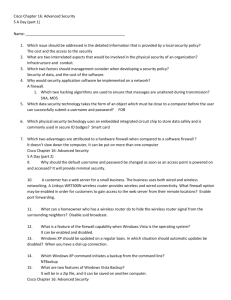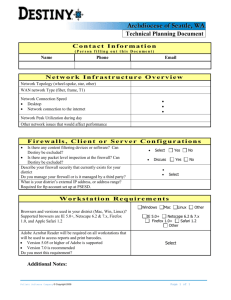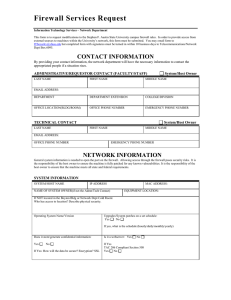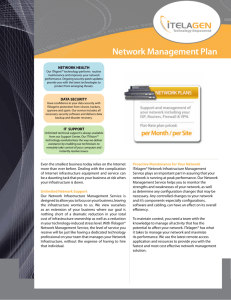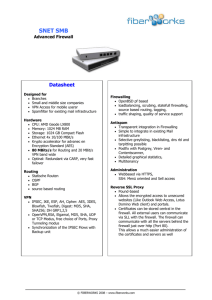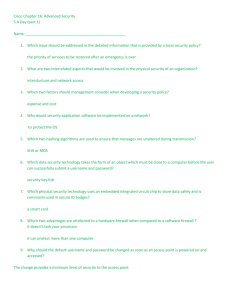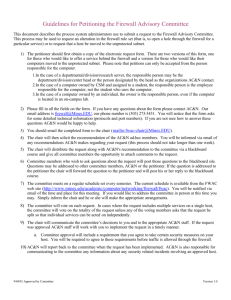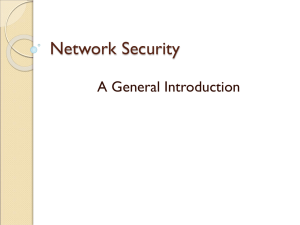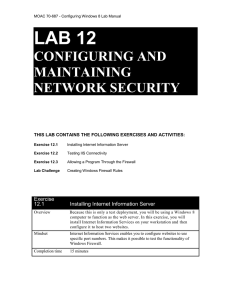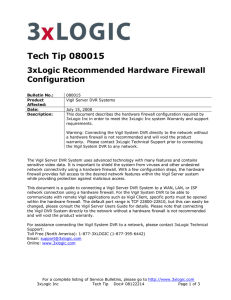Lecture 7 Network & ISP security Firewall Simple packet
advertisement
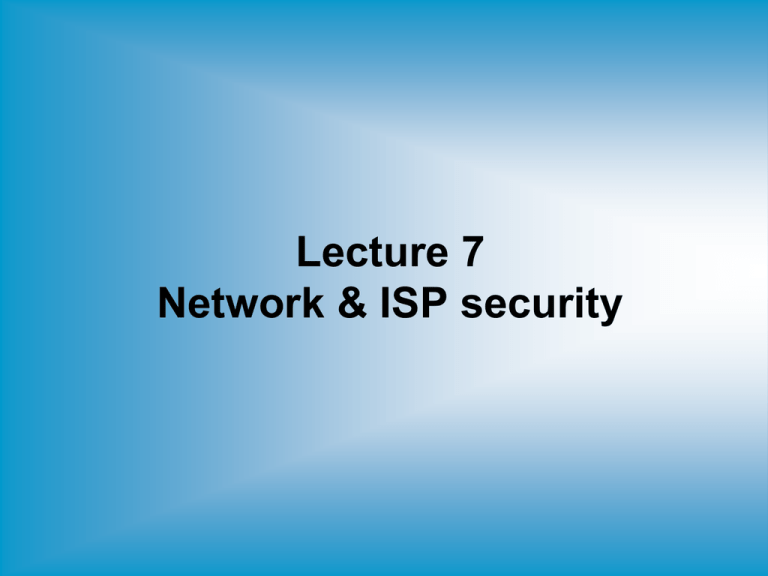
Lecture 7 Network & ISP security Firewall Simple packet-filters • Simple packet-filters evaluate packets based solely on IP headers. • Source-IP spoofing attacks generally aren't blocked by packet-filters, and since allowed packets are literally passed through the firewall, packets with "legitimate" IP headers but dangerous data payloads (as in bufferoverflow attacks) can often be sent intact to "protected" targets. Stateful packet filtering Application-layer proxies • A proxying firewall acts as an intermediary in all transactions that traverse it (see figure). • proxying firewalls are often called "applicationlayer" proxies because, unlike other types of proxies that enhance performance but not necessarily security, proxying firewalls usually have a large amount of application-specific intelligence about the services they broker. Placing Firewall "Inside Versus Outside" Architecture •Because public services such as SMTP, DNS, and HTTP must either be sent through the firewall to internal servers or hosted on the firewall itself the risk of server compromising is increased. •As result the DMZ (DeMilitarized Zone) network is used. The "Three-Homed Firewall" DMZ Architecture A Weak Screened-Subnet Architecture • Rarely used • Lack of firewall is the weak point • obsolete A Strong Screened-Subnet Architecture What Do ISPs Need to Do? Security incidence are a normal part of an ISP’s operations! 2) Secure Resources Firewall, Encryption, Authentication, Audit 5) Manage and Improve Post Mortem, Analyze the Incident, modify the plan/procedures 1) ISP’s Security Policy 4) Test, Practice, Drill Vulnerability Scanning 3) Monitor and Respond Intrusion Detection, work the incidence, Six Phases of Incident Response PREPARATION POST MORTEM What was done? Can anything be done to prevent it? How can it be less painful in the future? Prep the network Create tools Test tools Prep procedures Train team Practice IDENTIFICATION How do you know about the attack? What tools can you use? What’s your process for communication? REACTION What options do you have to remedy? Which option is the best under the circumstances? CLASSIFICATION TRACEBACK Where is the attack coming from? Where and how is it affecting the network? What kind of attack is it? Router CPU The Old World: Router Perspective “untrusted” Attacks, junk • Policy enforced at process level (VTY ACL, SNMP ACL, etc.) • Some early features such as ingress ACL used when possible Router CPU “untrusted” Protection The New World: Router Perspective Attacks, junk • Central policy enforcement, prior to process level • Granular protection schemes • On high-end platforms, hardware implementations Secure Routing Route Authentication Configure Routing Authentication Campus Signs Route Updates Verifies Signature Signature Route Updates Certifies Authenticity of Neighbor and Integrity of Route Updates References • • http://www.cs.fsu.edu/~burmeste/CIS4360/Physical%20Security.ppt http://www.google.com/url?sa=t&rct=j&q=datacenter%20security%20design%20 examplee%20ppt&source=web&cd=10&ved=0CHEQFjAJ&url=http%3A%2F%2 Fwww.nanog.org%2Fmeetings%2Fnanog36%2Fpresentations%2Fgreene.ppt& ei=6usCT8rmAsfQ4QSN6_GCDw&usg=AFQjCNHw7IRd4CrNra6tKNR_3Dfp7D_Ig&cad=rja • http://www.cs.fsu.edu/~burmeste/CIS4360/Physical%20Security.ppt • • • • • • • • https://www.owasp.org/index.php/Threat_Risk_Modeling http://www.cert.org/octave/ Joseph G. Boyce Dan W. Jennings, Information Assurance - Managing Organizational IT Security Risks, Elsevier Science, 2002 https://www.networkworld.com/news/2010/020210-black-hat-processorsecurity.html http://www.backupcentral.com/mr-backup-blog-mainmenu-47/13-mr-backupblog/167-encrypted-data-hacked.html http://www.csoonline.com/article/220665/19-ways-to-build-physical-security-intoa-data-center?page=3 http://fengnet.com/book/bssl/bssrvrlnx-CHP-2-SECT-2.html http://www.checkpoint.com/ Any wall have some weak points

